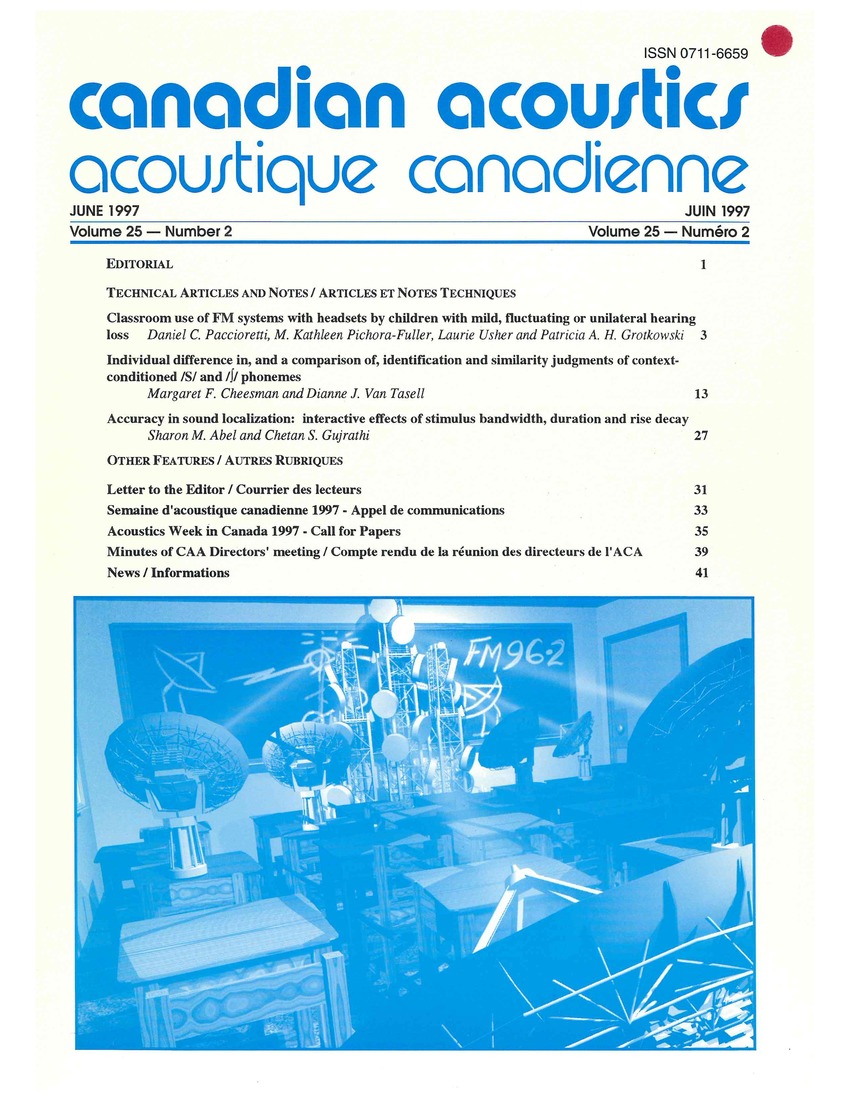Classroom use of FM systems with headsets by children with mild, fluctuating, or unilateral hearing loss
Keywords:
Architectural acoustics, Audition, Frequency modulation, Headphones, Performance, Subjective testing, Cost benefit analysis, Frequency modulated systems, Headset, Hearing loss, Pre trial factors, Signal to noise enhancementAbstract
Twenty school-age children with hearing loss that was minimal (16 to 25 dBHL) to mild (26 to 40 dBHL), fluctuating conductive, or unilateral were fit with personal FM systems with lightweight headsets for a two-month trial period in their classrooms. At the end of the trial period, the classroom teacher evaluated change in the child's classroom performance. This measure was used to evaluate the success of the trial. Prior to the trial period, the classroom teacher completed an evaluation of the child's classroom performance, and the children were tested by an audiologist in the soundbooth in unaided and aided conditions. The pre-trial measures were considered for their possible value in predicting which children would be successful users of the equipment. The FM system with headset was found to be beneficial for about 80% of the children. However, there was no single pre-trial indicator or combination of indicators that could be used to predict who would or would not be a good candidate for long-term use of the equipment. These findings suggest that before making a final decision regarding the suitability of an FM system with headset for use by a child, it is necessary to consider pre-trial factors (type of classroom, classroom behavior, academic performance, audiometric results, and personal factors), as well as evidence gathered during a trial period. Furthermore, since most children showed some benefit from the signal-to-noise enhancement provided by the equipment, another long-term strategy may be to design classrooms which are less acoustically hostile. A cost-benefit analysis of these alternatives should be undertaken.Additional Files
Published
How to Cite
Issue
Section
License
Author Licensing Addendum
This Licensing Addendum ("Addendum") is entered into between the undersigned Author(s) and Canadian Acoustics journal published by the Canadian Acoustical Association (hereinafter referred to as the "Publisher"). The Author(s) and the Publisher agree as follows:
-
Retained Rights: The Author(s) retain(s) the following rights:
- The right to reproduce, distribute, and publicly display the Work on the Author's personal website or the website of the Author's institution.
- The right to use the Work in the Author's teaching activities and presentations.
- The right to include the Work in a compilation for the Author's personal use, not for sale.
-
Grant of License: The Author(s) grant(s) to the Publisher a worldwide exclusive license to publish, reproduce, distribute, and display the Work in Canadian Acoustics and any other formats and media deemed appropriate by the Publisher.
-
Attribution: The Publisher agrees to include proper attribution to the Author(s) in all publications and reproductions of the Work.
-
No Conflict: This Addendum is intended to be in harmony with, and not in conflict with, the terms and conditions of the original agreement entered into between the Author(s) and the Publisher.
-
Copyright Clause: Copyright on articles is held by the Author(s). The corresponding Author has the right to grant on behalf of all Authors and does grant on behalf of all Authors, a worldwide exclusive license to the Publisher and its licensees in perpetuity, in all forms, formats, and media (whether known now or created in the future), including but not limited to the rights to publish, reproduce, distribute, display, store, translate, create adaptations, reprints, include within collections, and create summaries, extracts, and/or abstracts of the Contribution.


